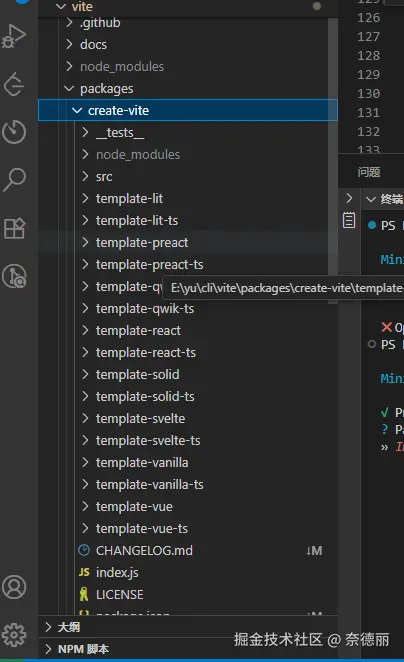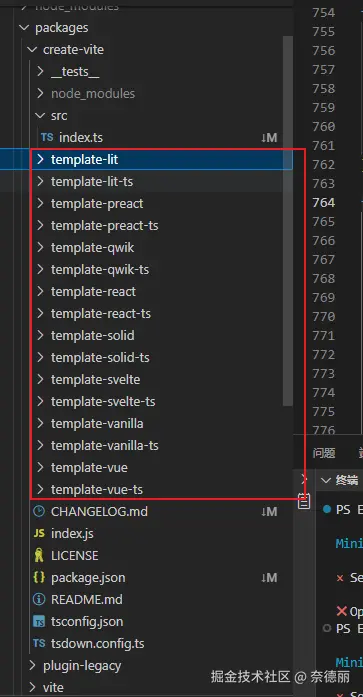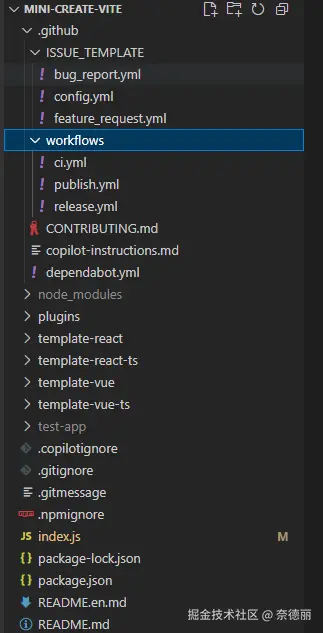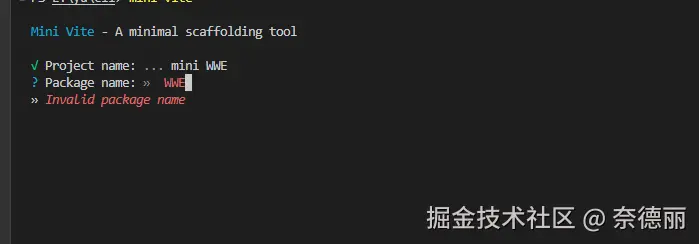前言
大家好,我是奈德丽。
周末闲着没事,突然想研究一下 create-vite 是怎么实现的。打开源码一看,我人都傻了------核心逻辑就几百行代码!这让我突然来了兴致:既然这么简单,为什么不自己撸一个呢?
于是我花了一个周末的时间,从零开始实现了一个简化版的脚手架工具 custom-create-vite。虽然功能没有官方的全面,但该有的都有,而且还加了一些自己觉得好用的特性,比如eslint、tailwind等。
今天就来和大家分享一下整个实现过程,以及我踩过的那些坑,如果你也想有一个自己的cli工具,不妨花几分钟看一看。
为什么要造这个轮子?
可能有人会问:官方的 create-vite 不是挺好用的吗?干嘛要自己写?
说实话,我主要是出于这几个原因:
1. 学习目的
学习当然是为了解决自己的疑惑,以前通过npm create vite,不知道实际上是怎么运行的,之前一直以为我执行了这个命令之后,vite cli是根据用户选择实时动态生成内容,简单点说,就是当你在Vue、React等众多框架中选择Vue时,cli是动态生成了vue模板,其实不是这样,它是提前创建了很多个template,比如js和ts就对应了不同模板,而React和Vue也是,他俩组合就有4个模板。


2. 团队定制需求
我们团队有一些固定的开发规范,比如统一用 Antfu 的 ESLint 配置、Tailwind CSS v4 等等。每次创建新项目都要手动配置这些东西,贼烦。如果能在脚手架里预置这些选项,那就爽歪歪了。
3. 插件化扩展
我想实现一个插件系统,让用户在创建项目的时候就能选择要不要装 ESLint、Tailwind CSS、UnoCSS 这些工具。这样新项目开箱即用,不用再手动配置。
基于这些想法,我开始动手了。
技术选型
既然是 2025 年了,那必须得用现代化的技术栈:
- prompts:交互式命令行工具,API 简单,体积小
- picocolors:给终端输出加点颜色,提升用户体验
没错,整个项目只依赖这两个包:
json
{
"dependencies": {
"prompts": "^2.4.2",
"picocolors": "^1.1.1"
}
}项目结构设计
在动手写代码之前,我先规划了一下项目主要结构:
bash
mini-vite/
├── index.js # 主入口文件
├── plugins/ # 插件系统
│ ├── index.js # 插件管理器
│ ├── eslint.js # ESLint 插件
│ ├── tailwind.js # Tailwind CSS 插件
│ └── unocss.js # UnoCSS 插件
├── template-vue/ # Vue JavaScript 模板
├── template-vue-ts/ # Vue TypeScript 模板
├── template-react/ # React JavaScript 模板
├── template-react-ts/ # React TypeScript 模板
└── package.json结构很清晰:
- 主逻辑放在
index.js - 插件系统独立成
plugins目录,方便扩展 - 每个模板都是独立的目录,包含完整的项目文件
除了主要目录,我还搭建了工作流,以及github 原生dependabot,如果有小伙伴感兴趣的话,后期可以写一篇文章专门讲一讲如何配置。

核心流程实现
下面讲讲具体的实现细节。整个流程可以分为 7 个步骤:
第一步:配置命令行入口
首先在 package.json 里声明 bin 字段:
json
{
"name": "mini-vite",
"type": "module",
"bin": {
"mini-vite": "index.js",
"create-mini-vite": "index.js"
}
}注意两点:
- type 必须设置为 module,这样才能用 ES Module 语法
- 我配置了两个命令名,用户可以用
mini-vite或create-mini-vite,怎么顺手怎么来
然后在 index.js 开头加上 shebang:
js
#!/usr/bin/env node这一行告诉系统用 Node.js 来执行这个文件。没有这一行,直接运行会报错。
第二步:询问项目名称
js
import prompts from 'prompts'
import colors from 'picocolors'
const { cyan, green, yellow, red, reset } = colors
async function init() {
console.log(`\n${cyan('Mini Vite')} - A minimal scaffolding tool\n`)
let targetDir = 'mini-vite-project'
const result = await prompts({
type: 'text',
name: 'projectName',
message: reset('Project name:'),
initial: targetDir,
onState: (state) => {
targetDir = state.value?.trim() || targetDir
}
})
if (!result.projectName) {
console.log('\n' + red('✖') + ' Operation cancelled')
return
}
}
init().catch((e) => {
console.error(red('Error:'), e)
process.exit(1)
})用 prompts 询问用户输入项目名称,默认是 mini-vite-project。如果用户直接按回车或者 Ctrl+C 取消,就退出程序。
第三步:检查目录是否存在
js
import fs from 'fs'
import path from 'path'
const root = path.join(process.cwd(), targetDir)
// 判断目录是否为空
function isEmpty(path) {
const files = fs.readdirSync(path)
return files.length === 0 || (files.length === 1 && files[0] === '.git')
}
// 清空目录
function emptyDir(dir) {
if (!fs.existsSync(dir)) return
for (const file of fs.readdirSync(dir)) {
if (file === '.git') continue
fs.rmSync(path.resolve(dir, file), { recursive: true, force: true })
}
}
if (fs.existsSync(root) && !isEmpty(root)) {
const response = await prompts({
type: 'select',
name: 'overwrite',
message: `Target directory "${targetDir}" is not empty. Please choose:`,
choices: [
{ title: 'Cancel', value: 'no' },
{ title: 'Remove existing files', value: 'yes' }
]
})
if (response.overwrite === 'no') {
console.log('\n' + red('✖') + ' Operation cancelled')
return
} else if (response.overwrite === 'yes') {
console.log(`\nRemoving existing files in ${targetDir}...`)
emptyDir(root)
}
}这里我踩了个坑!一开始我用 fs.rmdirSync(),结果发现如果目录非空就会报错。后来改成 fs.rmSync() 配合 recursive: true,才能递归删除整个目录。
第四步:验证包名
js
function isValidPackageName(projectName) {
return /^(?:@[a-z\d\-*~][a-z\d\-*._~]*\/)?[a-z\d\-~][a-z\d\-._~]*$/.test(projectName)
}
function toValidPackageName(projectName) {
return projectName
.trim()
.toLowerCase()
.replace(/\s+/g, '-')
.replace(/^[._]/, '')
.replace(/[^a-z\d\-~]+/g, '-')
}
let packageName = path.basename(root)
if (!isValidPackageName(packageName)) {
const response = await prompts({
type: 'text',
name: 'packageName',
message: reset('Package name:'),
initial: toValidPackageName(packageName),
validate: (name) => isValidPackageName(name) || 'Invalid package name'
})
packageName = response.packageName
}npm 包名有一定的规范,不能有大写字母、空格、特殊字符等。所以需要验证一下,如果不合法就提示用户重新输入。

第五步:选择框架和变体
js
const FRAMEWORKS = [
{
name: 'vue',
display: 'Vue',
color: green,
variants: [
{ name: 'vue-ts', display: 'TypeScript', color: blue },
{ name: 'vue', display: 'JavaScript', color: yellow }
]
},
{
name: 'react',
display: 'React',
color: cyan,
variants: [
{ name: 'react-ts', display: 'TypeScript', color: blue },
{ name: 'react', display: 'JavaScript', color: yellow }
]
}
]
// 选择框架
const frameworkResponse = await prompts({
type: 'select',
name: 'framework',
message: reset('Select a framework:'),
choices: FRAMEWORKS.map(framework => ({
title: framework.color(framework.display),
value: framework
}))
})
const framework = frameworkResponse.framework
if (!framework) {
console.log('\n' + red('✖') + ' Operation cancelled')
return
}
// 选择变体(TypeScript 或 JavaScript)
const variantResponse = await prompts({
type: 'select',
name: 'variant',
message: reset('Select a variant:'),
choices: framework.variants.map(variant => ({
title: variant.color(variant.display),
value: variant.name
}))
})
const template = variantResponse.variant这里我用了两级选择:先选框架(Vue 或 React),再选变体(TypeScript 或 JavaScript)。这样交互更清晰,用户体验更好。
每个选项都用不同的颜色标识,视觉效果更友好。
第六步:选择增强功能(插件系统)
这是我觉得最有意思的部分!一开始我vite cli 的swc也是动态插入的,但是并没有这种插件模块,我想了一下还是通过单独的模块来实现一个插件系统,因为后续会扩展更多的插件,这样可扩展性也更高点
js
// 5. 选择增强功能(可选)
const featuresResponse = await prompts([
{
type: 'multiselect',
name: 'features',
message: reset('Select additional features:'),
//把多选一的插件排除掉
choices: getPluginChoices().filter(choice => !['tailwind', 'unocss'].includes(choice.value)),
hint: '- Space to select. Return to submit',
instructions: false
}
])
const selectedFeatures = featuresResponse.features || []
// 6. 选择 CSS 框架(单选,可选)
const cssFrameworkResponse = await prompts({
type: 'select',
name: 'cssFramework',
message: reset('Select a CSS framework (optional):'),
choices: [
{ title: 'None', value: null },
{ title: 'Tailwind CSS v4', value: 'tailwind', description: 'Utility-first CSS framework' },
{ title: 'UnoCSS', value: 'unocss', description: 'Instant on-demand Atomic CSS' }
]
})
if (cssFrameworkResponse.cssFramework) {
selectedFeatures.push(cssFrameworkResponse.cssFramework)
}我把插件分成了两类:
- 通用功能:ESLint(多选)等不能同时选择的扩展
- CSS 框架:Tailwind CSS 或 UnoCSS(单选)
为什么要分开呢?因为 CSS 框架是互斥的,不能同时装 Tailwind 和 UnoCSS,会冲突。所以必须用单选。
第七步:复制模板并应用插件
js
import { fileURLToPath } from 'url'
import { applyPlugins } from './plugins/index.js'
const currentDir = path.dirname(fileURLToPath(import.meta.url))
const templateDir = path.resolve(currentDir, `template-${template}`)
// 复制文件的工具函数
function copy(src, dest) {
const stat = fs.statSync(src)
if (stat.isDirectory()) {
copyDir(src, dest)
} else {
fs.copyFileSync(src, dest)
}
}
function copyDir(srcDir, destDir) {
fs.mkdirSync(destDir, { recursive: true })
for (const file of fs.readdirSync(srcDir)) {
const srcFile = path.resolve(srcDir, file)
const destFile = path.resolve(destDir, file)
copy(srcFile, destFile)
}
}
// 创建目标目录
fs.mkdirSync(root, { recursive: true })
// 复制模板文件
const files = fs.readdirSync(templateDir)
for (const file of files.filter(f => f !== 'package.json')) {
const srcFile = path.join(templateDir, file)
const destFile = path.join(root, file)
copy(srcFile, destFile)
}
// 读取并修改 package.json
const pkgPath = path.join(templateDir, 'package.json')
const pkg = JSON.parse(fs.readFileSync(pkgPath, 'utf-8'))
pkg.name = packageName
// 应用选中的插件
applyPlugins(selectedFeatures, root, template, pkg)
// 写入 package.json
fs.writeFileSync(
path.join(root, 'package.json'),
JSON.stringify(pkg, null, 2) + '\n'
)这里有个小细节:因为用了 ES Module,没有 __dirname 变量,所以要用 import.meta.url 配合 fileURLToPath 来获取当前文件路径。
复制文件的逻辑很简单:递归遍历模板目录,把每个文件都复制到目标目录。
最关键的是 applyPlugins 这一步,它会根据用户选择的插件,动态修改项目配置。
插件系统的设计
插件系统是整个项目的核心,我花了不少时间来设计它的架构。
插件的标准结构
每个插件都是一个独立的 JS 文件,导出一个对象:
js
// plugins/eslint.js
export const eslintPlugin = {
name: 'eslint',
title: 'ESLint + Prettier (Antfu Config)',
description: 'Code quality and formatting',
setup(root, template, pkg) {
// 1. 添加依赖
pkg.devDependencies = pkg.devDependencies || {}
pkg.devDependencies['eslint'] = '^9.39.1'
pkg.devDependencies['@antfu/eslint-config'] = '^6.2.0'
// 2. 创建配置文件
const configContent = `import antfu from '@antfu/eslint-config'
export default antfu()`
fs.writeFileSync(
path.join(root, 'eslint.config.js'),
configContent
)
console.log(`${green('✔')} ESLint configured`)
}
}每个插件包含:
- name:插件标识
- title:显示给用户看的名称
- description:简短描述
- setup :安装函数,接收
root(项目目录)、template(模板名称)、pkg(package.json 对象)三个参数
插件管理器
js
// plugins/index.js
import { eslintPlugin } from './eslint.js'
import { tailwindPlugin } from './tailwind.js'
import { unocssPlugin } from './unocss.js'
export const plugins = {
eslint: eslintPlugin,
tailwind: tailwindPlugin,
unocss: unocssPlugin
}
// 插件执行顺序
const pluginOrder = {
eslint: 1,
tailwind: 2,
unocss: 2
}
export function applyPlugins(selectedPlugins, root, template, pkg) {
// 按优先级排序
const sortedPlugins = [...selectedPlugins].sort((a, b) => {
const orderA = pluginOrder[a] || 999
const orderB = pluginOrder[b] || 999
return orderA - orderB
})
for (const pluginName of sortedPlugins) {
const plugin = plugins[pluginName]
if (!plugin) {
console.error(`${red('✖')} Plugin "${pluginName}" not found`)
continue
}
try {
plugin.setup(root, template, pkg)
} catch (error) {
console.error(`${red('✖')} Failed to configure ${plugin.title}`)
console.error(` ${error.message}`)
}
}
}插件管理器负责:
- 按优先级排序插件(ESLint 要先执行,CSS 框架后执行)
- 依次调用每个插件的
setup方法 - 错误处理,防止某个插件失败导致整个流程崩溃
Tailwind CSS v4 插件
这里我又踩了个坑!
Tailwind CSS v4 的配置方式和 v3 完全不同。v3 需要创建 tailwind.config.js 和 postcss.config.js,但 v4 简化了很多:
js
// plugins/tailwind.js
export const tailwindPlugin = {
name: 'tailwind',
title: 'Tailwind CSS v4',
description: 'Utility-first CSS framework',
setup(root, template, pkg) {
// 1. 添加依赖
pkg.devDependencies['tailwindcss'] = '^4.1.0'
pkg.devDependencies['@tailwindcss/vite'] = '^4.1.0'
// 2. 创建 CSS 文件
const cssPath = path.join(root, 'src/index.css')
fs.writeFileSync(cssPath, '@import "tailwindcss";\n')
// 3. 修改 vite.config.js
const viteConfigPath = path.join(root, 'vite.config.js')
let viteConfig = fs.readFileSync(viteConfigPath, 'utf-8')
// 在 import 区域添加
viteConfig = viteConfig.replace(
/(import .+ from .+\n)/,
`$1import tailwindcss from '@tailwindcss/vite'\n`
)
// 在 plugins 数组添加
viteConfig = viteConfig.replace(
/plugins:\s*\[/,
'plugins: [tailwindcss(), '
)
fs.writeFileSync(viteConfigPath, viteConfig)
console.log(`${green('✔')} Tailwind CSS v4 configured`)
}
}这里采用的最新版的v4 tailwindcss,v4 的配置步骤:
- 安装
tailwindcss和@tailwindcss/vite - 在 CSS 文件里写
@import "tailwindcss"; - 在
vite.config.js引入 Vite 插件
不需要 创建 tailwind.config.js 和 postcss.config.js!
UnoCSS 插件
js
// plugins/unocss.js
export const unocssPlugin = {
name: 'unocss',
title: 'UnoCSS',
description: 'Instant on-demand Atomic CSS',
setup(root, template, pkg) {
// 1. 添加依赖
pkg.devDependencies['unocss'] = '^0.64.6'
// 2. 创建配置文件
const configContent = `import { defineConfig } from 'unocss'
export default defineConfig({
// 你的配置
})`
fs.writeFileSync(
path.join(root, 'uno.config.ts'),
configContent
)
// 3. 修改 vite.config.js
const viteConfigPath = path.join(root, 'vite.config.js')
let viteConfig = fs.readFileSync(viteConfigPath, 'utf-8')
viteConfig = viteConfig.replace(
/(import .+ from .+\n)/,
`$1import UnoCSS from 'unocss/vite'\n`
)
viteConfig = viteConfig.replace(
/plugins:\s*\[/,
'plugins: [UnoCSS(), '
)
fs.writeFileSync(viteConfigPath, viteConfig)
// 4. 修改 main 入口文件
const isVue = template.startsWith('vue')
const mainFile = isVue ? 'main.js' : 'main.jsx'
const mainPath = path.join(root, 'src', mainFile)
let mainContent = fs.readFileSync(mainPath, 'utf-8')
mainContent = `import 'virtual:uno.css'\n${mainContent}`
fs.writeFileSync(mainPath, mainContent)
console.log(`${green('✔')} UnoCSS configured`)
}
}UnoCSS 的配置相对复杂一点:
- 创建
uno.config.ts - 修改
vite.config.js引入插件 - 在入口文件(
main.js或main.jsx)引入virtual:uno.css
模板设计
因为平常主要用Vue和React比较多,我为 Vue 和 React 各准备了 JS 和 TS 两个版本,一共 4 个模板。
Vue 模板
arduino
template-vue/
├── index.html
├── vite.config.js
├── package.json
├── public/
│ └── vite.svg
└── src/
├── main.js
├── App.vue
├── style.css
├── components/
│ └── HelloWorld.vue
└── assets/
└── vue.svgpackage.json:
json
{
"name": "vite-project",
"private": true,
"version": "0.0.0",
"type": "module",
"scripts": {
"dev": "vite",
"build": "vite build",
"preview": "vite preview"
},
"dependencies": {
"vue": "^3.5.13"
},
"devDependencies": {
"@vitejs/plugin-vue": "^5.2.1",
"vite": "^6.0.5"
}
}vite.config.js:
js
import { defineConfig } from 'vite'
import vue from '@vitejs/plugin-vue'
export default defineConfig({
plugins: [vue()]
})React 模板
arduino
template-react/
├── index.html
├── vite.config.js
├── package.json
├── public/
│ └── vite.svg
└── src/
├── main.jsx
├── App.jsx
├── index.css
├── components/
│ └── Counter.jsx
└── assets/
└── react.svgpackage.json:
json
{
"name": "vite-project",
"private": true,
"version": "0.0.0",
"type": "module",
"scripts": {
"dev": "vite",
"build": "vite build",
"preview": "vite preview"
},
"dependencies": {
"react": "^18.3.1",
"react-dom": "^18.3.1"
},
"devDependencies": {
"@vitejs/plugin-react": "^4.3.4",
"@types/react": "^18.3.18",
"@types/react-dom": "^18.3.5",
"vite": "^6.0.5"
}
}TypeScript 版本就是在上面的基础上:
- 添加
tsconfig.json和tsconfig.node.json - 文件后缀改成
.ts或.tsx package.json里加上typescript依赖
使用方式
开发阶段,可以用node index.js或则是使用 npm link 把命令链接到全局:
bash
cd mini-vite
npm link然后就可以在任意目录使用了:
bash
mini-vite my-app或者:
bash
create-mini-vite my-app执行后会看到交互式界面:
vbnet
Mini Vite - A minimal scaffolding tool
? Project name: › my-app
? Select a framework: ›
Vue
React
? Select a variant: ›
TypeScript
JavaScript
? Select additional features: ›
◯ ESLint + Prettier (Antfu Config)
? Select a CSS framework (optional): ›
None
Tailwind CSS v4
UnoCSS
✔ Scaffolding project in /path/to/my-app...
✔ ESLint configured
✔ Tailwind CSS v4 configured
✔ Done!
Now run:
cd my-app
npm install
npm run dev踩过的坑
1. ES Module 的 __dirname 问题
在 ES Module 里没有 __dirname 和 __filename,要这样获取:
js
import { fileURLToPath } from 'url'
import path from 'path'
const __filename = fileURLToPath(import.meta.url)
const __dirname = path.dirname(__filename)我一开始直接用 __dirname,结果报错说未定义。查了文档才知道要用 import.meta.url。
2. Tailwind CSS v4 的配置变化
v4 不再需要 tailwind.config.js 和 postcss.config.js,直接在 CSS 里引入就行:
css
@import "tailwindcss";然后在 vite.config.js 引入 Vite 插件:
js
import tailwindcss from '@tailwindcss/vite'
export default defineConfig({
plugins: [tailwindcss()]
})我一开始还按 v3 的方式创建配置文件,浪费了好长时间。
3. 正则表达式修改 vite.config.js
用正则表达式修改配置文件的时候要特别小心:
js
// 不好的写法(假设格式固定)
content.replace('plugins: [', 'plugins: [tailwindcss(), ')
// 好的写法(考虑各种空格情况)
content.replace(/plugins:\s*\[/, 'plugins: [tailwindcss(), ')因为不同人写代码的格式可能不一样,有人写 plugins:[,有人写 plugins: [。用正则的 \s* 可以匹配任意空格。
和官方工具的对比
| 特性 | create-vite | mini-vite |
|---|---|---|
| 支持的框架 | 8+ | 2(Vue、React) |
| 模板数量 | 18+ | 4 |
| 依赖数量 | 3 | 2 |
| 插件系统 | ✗ | ✓(ESLint、Tailwind、UnoCSS) |
| 代码量 | ~500 行 | ~300 行 |
| 团队定制 | 困难 | 容易 |
| 学习难度 | 中等 | 简单 |
官方工具功能更全面,适合生产环境。我这个更轻量、更灵活,适合学习和团队定制。
写在最后
后续我会补充更多plugin,支持h5端不同机型适配、router和跨页面应用存储等通用功能 大家也可以尝试写一个自己的cli工具,无论是团队开发还是个人独立开发,我觉得都挺有用的,虽然现在ai很牛,有时候让它创建项目,也会出错,还得不断调试才能做好(吐槽一下)
emm 懦夫的味道...